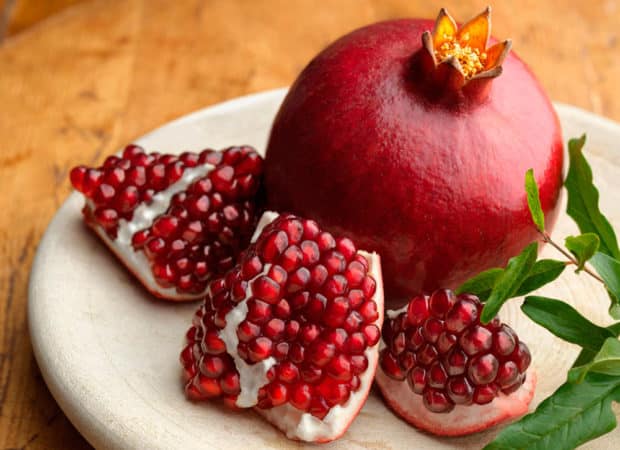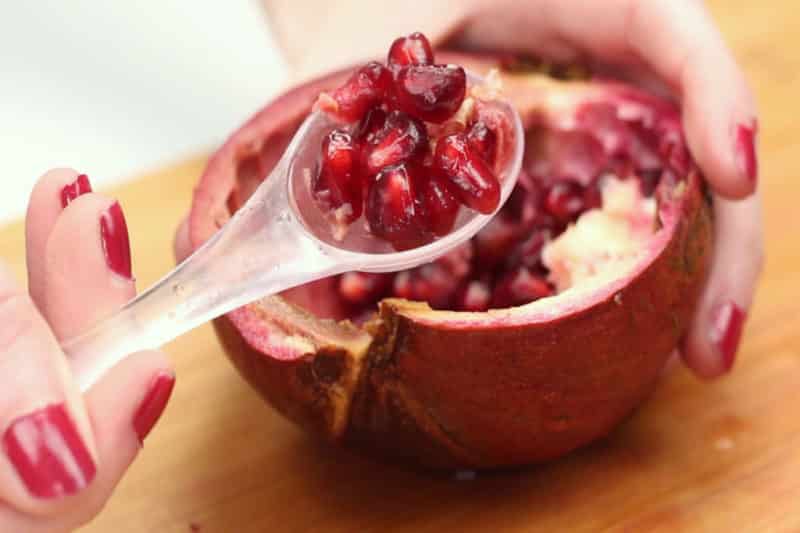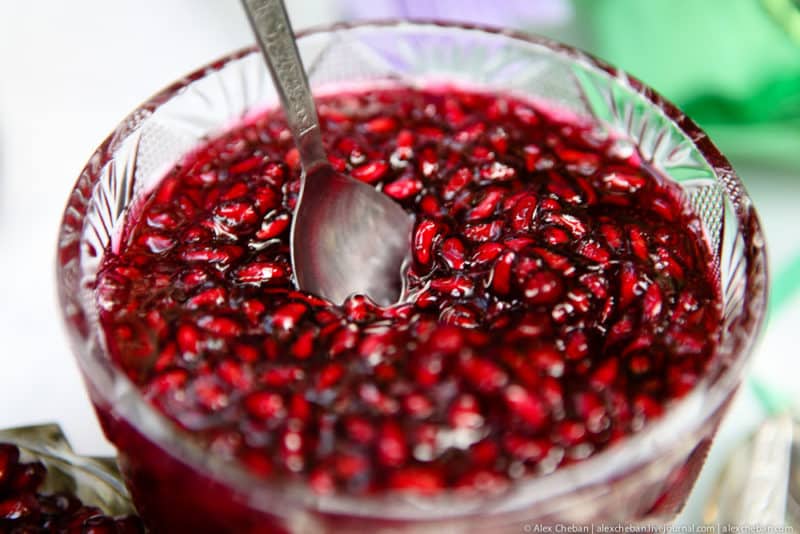What are the benefits of pomegranate with seeds and how many calories does it contain?
Ripe and juicy pomegranate seeds are unlikely to leave anyone indifferent. After all, they not only have a wonderful taste, but also have undeniable beneficial properties. Let's figure out what this fruit is rich in and how many calories are in a pomegranate with seeds.
Calorie content of pomegranate with seeds
Pomegranate is considered one of the healthiest fruits and is recommended by nutritionists as a source of vitamins and microelements.
Despite its sweetness, this fruit contains a small amount of carbohydrates and is considered low-calorie: only 52 kcal per 100 g of product.

Calorie content depending on variety
The calorie content of pomegranates depends not only on the variety, but also on the degree of ripeness of the fruit.
Sweeter fruits grown in Central Asia, Turkmenistan, and Azerbaijan contain about 52 kcal per 100 g of peeled grains.
More sour ones (for example, Georgian) are less caloric, per 100 g there are from 49 to 50 kcal.
Glycemic index
The glycemic index of pomegranate is considered low and is only 35 units.
For comparison, carrots, apples, whole grain bread and milk chocolate have the same value.
BJU
Proteins are contained in small quantities (0.7 g and 3 kcal per 100 g) in the pulp and seeds.
Bananas are considered the record holders among fruits for protein (1.5 g per 100 g), and apples contain only 0.4 g of protein.
Like most fruits, peeled pomegranate seeds do not contain fats. However, a small amount is present in the seeds (about 0.6 g), which is 5 kcal.
But there are not so few carbohydrates in grains - 13.9 g. This is 2 times more than in the same amount of grapefruit.
Composition and properties
Pomegranate is a unique source of vitamins and microelements. Depending on the degree of ripeness, nitrogenous compounds, tannins, flavonoids, catechins, and amino acids (oleic, linoleic, stearic, omega-7, omega-9, lauric) were found in the juice of this fruit.
100 g of this fruit contains:
- Vitamin C – 10.2 mg. It is involved in the synthesis of collagen and is responsible for the condition of connective and cartilaginous tissues, tendons, teeth, gums, ligaments, and skin. Its deficiency leads to disruption of hematopoietic processes and decreased immunity, as well as acidification of the body and premature aging.
- Vitamin B4 – 7.6 mg. Responsible for the formation of connective tissues, the functioning of the liver, nervous and endocrine systems. Lack of B4 leads to increased cholesterol in the blood, memory impairment, insomnia and excess weight. Choline is an important element of fat metabolism. It is involved in the formation of lecithin and prevents the accumulation of visceral (internal) fat.
- Vitamin E – 0.6 mg. It is a powerful antioxidant that helps eliminate free radicals from the body. With a severe deficiency of vitamin E, the condition of the skin, hair, nails worsens, and problems with the reproductive system arise.
- Vitamin B5 – 0.377 mg. Another name for the substance is pantothenic acid; without it, the normal formation and functioning of all types of cells in the body is impossible. Lack of B5 has a detrimental effect on vision, liver, kidneys, and nervous system.
- Vitamin B3 – 0.293 mg. Responsible for converting fats and carbohydrates into energy, normalizes the functioning of the gastrointestinal tract, and its deficiency leads to oxygen starvation of all cells of the body. The need for B3 increases sharply during high physical and nervous stress, as well as during pregnancy and lactation.
- Potassium – 236 mg. Present in all tissues of the body, it is responsible for the speed of neural reactions, blood pressure levels, and hematopoietic processes. Deficiency leads to strokes, arrhythmias and bone fragility.
- Phosphorus – 35 mg. It is found in large quantities in bones and teeth, affects mental activity, is involved in protein synthesis, and is also part of DNA.
- Calcium – 10 mg. Responsible for the condition of the nervous system, bones and teeth, proper hormonal balance. Calcium deficiency leads to impaired absorption of vitamin D and the occurrence of osteoporosis.
- Magnesium – 12 mg. Participates in all metabolic reactions, the synthesis of proteins and some nucleic acids. Important for maintaining muscle and skeletal health and the immune system.
- Sodium – 3 mg. Contained in cellular and intercellular fluid, nerve fibers and muscles. Its deficiency leads to seizures, acidification of the body, and sudden jumps in blood pressure.
Pomegranate contains small amounts of iron, zinc, copper, manganese and selenium, as well as beta-sitosterol, which is responsible for longevity and health of the body.
How to eat pomegranate: with or without seeds

It is believed that you should not eat pomegranate with seeds, as this can lead to inflammation of the cecum - appendix. However, this is absolutely not true.
Research conducted by Turkish doctors revealed that out of 2,000 removed appendixes, only 4 contained undigested remains of fruit seeds.Scientists have been able to establish that this cannot lead to any serious health problems.
Are pomegranate seeds healthy?
- improve intestinal motility;
- promote cleansing of accumulated toxins;
- contain unique oils and polyunsaturated acids that have a positive effect on the heart, nervous and endocrine systems.
How many calories in 100 g
The calorie content of pomegranate varies depending on the variety and degree of ripeness, as well as how exactly the grains are use for food.
100 g of unpeeled fruit contains 52 kcal, peeled - 72 kcal, with seeds - 56.4 kcal, seedless – 58.7 kcal.
Whole fresh pomegranate
The average weight of a ripe pomegranate (with skin and seeds) is from 300 to 350 g, and its calorie content is 156 kcal. On average, one fruit contains from 150 to 170 g of grains, which is half the weight of the entire fruit.
Smaller varieties grown in Spain and Greece do not exceed 200 g in weight. They are tart because they contain less sugars. The calorie content of such a pomegranate does not exceed 75-80 kcal.
In juice

The calorie content depends on how the juice is prepared. When directly pressing fresh fruits, no sugar is added, and the safety of the product is ensured by pasteurization. All nutrients are preserved, and the calorie content of 100 g is only 64 kcal.
If concentrate is used to prepare juice, manufacturers add sweeteners in addition to water. The nutritional value of such a drink is somewhat lower, but the calorie content and carbohydrate content increase significantly. On average, 100 g of juice contains from 92 to 110 kcal.
In processed fruit
The most popular sweet is pomegranate dzhezerye. It is prepared by boiling pomegranate juice with sugar and nuts until thickened.
This oriental delicacy has a rich taste and good for your health. However, jezerye is very high in calories, 100 g contains at least 381 kcal, which is similar to 150 g of fatty pork or 350 g of chicken breast.

Pomegranate jam It has a delicate taste and contains vitamins and microelements. It is prepared from grains, freshly squeezed pomegranate juice and sugar, simmering over low heat until it becomes a thick syrup. Jam contains at least 450-500 kcal per 100 g, and therefore can easily replace a full 3-course meal.

Pomegranate compote is cooked with a minimum amount of sugar, and therefore does not stored more than six months. If you do not consume the drink before this date, all its beneficial properties will be lost. In 1 tbsp. This drink contains only 45-50 kcal.

Is it possible to eat pomegranates with seeds when losing weight on a diet?
Pomegranate contains vitamins, microelements, and fiber (at least 4 g per 100 g of weight). Dietary fiber contributes to normal intestinal function and the elimination of toxins. During a diet, pomegranate will strengthen the body and prevent weakness and insomnia.
Attention! Nutritionists recommend eating fresh pomegranate seeds 3-4 times a week in the morning. This will not only help you lose weight, but also prevent the development of anemia.
The fruit helps normalize hormonal levels, which is especially important in cases where excess weight is caused by improper functioning of the thyroid gland. Pomegranate seeds prevent puffiness, thereby promoting weight loss.
Health benefits and harms
The grains contain more than 10 vitamins, 8 microelements, as well as a complex of complex amino acids. The fruit is good for the heart; when consumed regularly, it has a tonic effect on the walls of blood vessels, normalizes blood pressure, and prevents the development of tachycardia and arrhythmia.
Pomegranate helps normalize the process of hematopoiesis and the synthesis of red blood cells. It is often recommended to be taken for anemia and bleeding disorders, as well as after severe operations accompanied by large blood loss. Pomegranate will help children and elderly people to support their immunity, especially in the autumn.
Pomegranate fruits can only be harmful if they are eaten in large quantities on an empty stomach. Excessive consumption can lead to damage to the mucous membrane and the occurrence of peptic ulcers, as well as allergic reactions.
Contraindications
Pomegranate fruits contain many active chemical compounds, and therefore can provoke allergic reactions. Since the fruit can cause heartburn, it is strictly contraindicated for pregnant and nursing mothers, as well as for those who suffer from stomach and duodenal ulcers.
Attention! Pomegranate peel should not be eaten or added to teas or decoctions. It contains toxic substances and causes poisoning.
Undiluted juice can thin and destroy tooth enamel and cause indigestion. It should not be used by patients with type 1 diabetes, people prone to constipation, hemorrhoids and hypertension.
How to choose and store correctly
A rich burgundy color is not at all an indicator that the fruit is ripe. Taste and sweetness depend on the variety, as well as the degree of ripeness. The “correct” fruit should have dry skin, without damage or dark spots.If there are fleshy protrusions in place of the flower or there is greenery present, the pomegranate was picked unripe, and it will definitely taste sour.
Before buying, you need to weigh the fruit in your hand: the heavier it is, the sweeter the grains. You should not take fruits that are too small; as a rule, these are sour varieties. But large (up to 500 g) pomegranates grown in Azerbaijan or Central Asia are always sweet.
Store pomegranate in a special container in the refrigerator at a temperature of about +5°C for no more than 1 month. In room conditions or with high humidity, the pomegranate will quickly deteriorate, and the grains will become dry and may rot.
Daily consumption rates
Doctors It is recommended to eat no more than 1 pomegranate per day weighing up to 250 g or drink 1 tbsp. natural juice.
Exceeding the norm will lead to hypervitaminosis and allergic reactions.
Conclusion
The benefits of pomegranate are great, because it contains a variety of vitamins, fiber, potassium, magnesium, calcium, sodium, and manganese salts. This fruit contains organic acids - citric, malic, oxalic, as well as phytoncides that suppress pathogenic microflora.